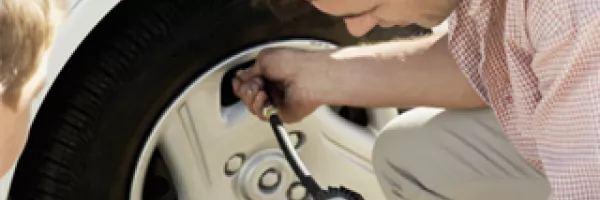
How to Maintain Proper Tire Pressure
As the seasons change and the road gets slippery with fallen leaves, rain, and ice, you won’t want to be left wondering whether your tires are in good condition. Fortunately, it’s easy to check the condition of your tires yourself.
Checking and adjusting your tire pressure is key to keeping tires in good condition and avoiding a disastrous tire failure, but many of us overlook it. Here are some tips to help you get familiar with maintaining the proper tire pressure, and how to incorporate it into your car care routine.
Why Does Proper Tire Pressure Matter?
The pressure of the air in your tires changes the way they contact the road. Overinflation makes tires rigid, preventing the whole tire tread from touching the road. This also causes the center of your tire tread to wear down faster and makes the ride feel rougher.
Underinflated tires can cause imprecise handling and premature wear on the tread at the edges of your tires. Underinflated tires may even overheat and fail at highway speeds. According to AAA and the National Highway Traffic Safety Administration, under-inflated tires contribute to more than 600 fatalities and 33,000 injuries every year.
Proper tire pressure can also save you money at the gas pump. The decrease in fuel economy caused by underinflated tires results in more than one billion gallons of wasted gasoline annually in the U.S. alone.
How to Maintain Your Tire Pressure
Find the Correct Pressure
Before you add or remove any air, you’ll need to look up the correct tire pressure for your car. This can be found on a tire and loading information label affixed to your driver’s side door edge, door post, or the inside of your glove compartment. You can also find it in your owner’s manual.
The tire pressure printed on the sidewall of your tires is the maximum air pressure that the tire can take, and probably isn’t the same as the correct pressure for your specific vehicle model. so always rely on the recommendation from your vehicle manufacturer.
Check Your Current Tire Pressure
There are several types of tire pressure gauges available: stick, dial, and digital. Each kind has its own advantages and disadvantages, but most are operated in the same way. Unscrew your tire valve cap, line up the gauge with the valve, and press the gauge down onto the valve to get a reading.
Don’t forget to check your spare tire too! Many spare tires have higher pressure recommendations than regular tires, so make sure to check your owner’s manual or the tire information label.
It’s best to check your tire pressure and add or remove air only when the tires are cold - this means that they have not been driven on for at least three hours. As you drive, the air in your tires heats up, and the pressure rises. Even driving as little as a mile can make a big difference.
Add or Remove Air
If the pressure reading is higher than the recommended level, let out some air. Some tire gauges have a small metal peg, often on the reverse side of the gauge attachment, which you can press into the air valve to let some air out. Alternatively, you can use a fingernail or the tip of a pen. Don’t release or “bleed” air when your tires are warm! You may release too much air, causing your tires to be underinflated.
If the pressure reading is lower than the recommended level, you’ll need to add some air to your tires. In California and Connecticut, gas stations are required to provide free compressed air. In other states, you may encounter coin-operated machines.
If you must drive to access compressed air, check and record your tire pressure first, and note how many pounds of air pressure you need to add to reach the recommended level. When you are ready to add air, check the pressure again, and add the missing pounds on top of that reading. When your tires cool down again, they should read the correct pressure.
After adjusting, recheck your tire pressure again to make sure it’s at the recommended level.
Don’t Rely on Tire Pressure Monitoring Systems
All cars manufactured since 2008 have a tire pressure monitoring system that activates an indicator light on the dashboard when at least one tire is more than 25% underinflated, a severe level of underinflation. This is particularly useful to warn of a rapid loss of pressure due to a puncture or an active leak.
However, many motorists treat this system as a replacement for regularly checking their tire pressure. In a 2007 survey by the Rubber Manufacturers Association, 40% of drivers reported that they wouldn’t check their tire pressure unless their tire pressure indicator light came on - an extremely risky habit.
Tires typically lose one pound of pressure per month just through normal seepage, so it’s best to check your tire pressure monthly and add more air as needed.
Tread Wear, Aging, Alignment, Rotation, Balance….
Proper tire pressure isn’t the only component of good tire care! Look for more tips in our next post.